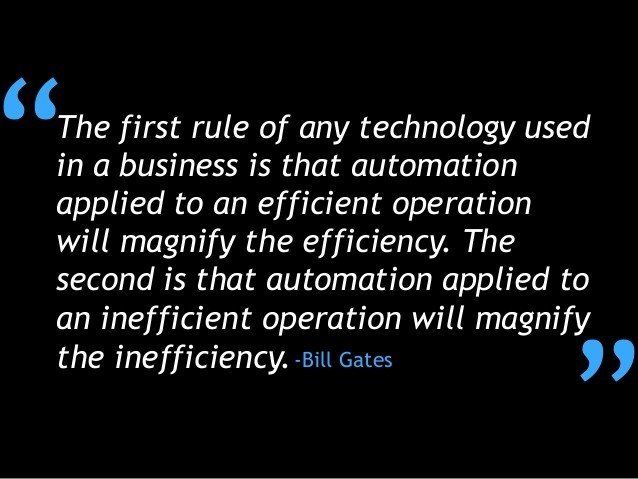Automate Complex Processes with Not So Complex ERP Solutions
Automate Complex Processes with Not So Complex ERP Solutions
Complexity vs. Inefficiency;
while many may think that complexity leads to inefficiency, it is actually not the case. Not all complex processes are inefficient, there are many efficient processes which are highly complex. The problem is the inefficiency in the processes themselves.
This is not to say that complex processes do not have room for improvement. On the contrary, if you find yourself confronted with questions related to complexity and inefficiency it is always worth considering if you or your team have over-complicated the issue. After all, processes that are unnecessarily complex (which often times they can become) can slow down productivity and decrease profits.
So, how do we eliminate inefficiencies
in a process? Simple. Eliminate the steps that do not add any benefit or value to the process. Even the processes that start out simple accumulates more steps overtime that make them bulky and difficult to understand. When trying to remove inefficiencies, ask yourself these questions; why was the process established in the first place? What is the final business result you are trying to achieve through this process?
To automate or not to automate...
When it comes to the topic of automation
it is worthwhile to look at the difference between a process that is complicated
vs a process that is complex. A complicated process can be broken down into sub-parts that can be defined, whereas a complex system has multiple variables that can never be defined completely. A general rule of thumb with regard to automation is do not consider your complex processes for automation first!
Instead, focus on automating your core, everyday processes to start with. Of course, automation of complex activities is likely to have a greater impact, but they are far more difficult to automate and require considerable time and effort. Automating a complex process without performing the proper legwork first will only add to more inefficiencies.
Also, remember to take a good endoscopic look at your processes and fix the broken processes before automating
them. So many are impressed with the efforts invested into an automated solution but not many are interested to fix or make the processes leaner before proceeding further. Automating a bad process is just encouraging the bad process to continue.
Is Simplification the new Competitive Advantage?
In the ever-changing business landscape, size and complexity no longer create a competitive advantage. During the era when size and complexity was in play, only large organizations could afford to implement and customize technologies like ERP systems. But today, additional complexity will only limit your organization’s ability to react to a dynamic marketplace that requires you to perform under extreme pressure just to stay relevant.
Today, market leaders invest in technologies that allow for rapid integration and modification, and only offer support for key business processes that are unlikely to change rapidly.
Simple means “readily understood or performed”
A critical step when it comes to simplification is to decide what steps can be dropped without affecting the overall process or output in a negative manner. There are plenty of tools out there that can help you with this task. A good place to start would be to check some process modelling tools to visualize and untangle the complexity. I use flow charts in MS Visio for this purpose but it can be any tool you are comfortable with. Using the right tools for these exercises will save you a lot of time.
There are some organizations in specific industries such as Engineer to Order or Process Manufacturers, who require complex business processes to solve difficult problems as part of their operations. For such organizations the right question is how to use complexity
to gain a competitive advantage? Basically, do not let the weeds grow back! Once you have done all the hard work getting the process simplified you need to maintain it. Have some housekeeping rules such as “new process can only replace an existing step”.
Finally, do not let the process of simplification kill your productivity and innovation. Many companies think that the use of TQM, ISO, Lean Six Sigma will miraculously improve their processes. These techniques only work if you know how, when, and where to apply them. Simply using them as a silver bullet will not get you the result you want.
Is my ERP solution too complex to automate?
I have seen companies dealing in multiple industries maintain specific ERP Systems for each stream just to avoid the workflow complexities. Often times they fail to realize that having separate systems will only increase the ERP landscape complexity, thereby missing the benefits of a unified application.
On the flipside there are those that choose to standardize their processes – both simple and complex – just to avoid having different workflows practiced in different business units.
You need to be a little cautious here. Do not fall for the ERP sales pitch that the system will tell you how to run the business; it is the other way around. ERP Systems carry a comprehensive set of processes, with the flexibility to configure the system based on your business requirement. Hence, the need to take the time and define the business processes before automation, and not after.
I have been in many ERP upgrade discussions where customers express the need to drop their customizations and change their processes to meet the ERPs best practices. ERP vendors introduce product enhancements with every release thereby increasing the complexity of the solution. These solutions only focus on the top 10% of the industry, which also means that the rest of the 90% pay for a solution that does not fit their processes. The complexity in an ERP System can stunt business growth. Therefore, avoid ERPs that do not fit your business processes at all costs!
When the business processes are diverse and complicated, they require complex systems to support them, making the total solution complex. IT support teams often struggle to keep up with the maintenance of the complex systems as well as the knowledge required to support the system.
“Diversification and complexity of the processes can push the limits of an ERP System”
Having well-designed, simple, modular ERP workflows with an emphasis on intuitive design will greatly help with the usability of the system. To automate a complex business workflow generally require an ERP with a lot of configuration options and workflows.
When you factor in the thousands of standard configurations in an ERP System with additional customizations as well as modifications to the core product, maintaining an automated solution can become a real problem. Furthermore, the challenges a company faces in their complex business operations, especially when they engage in multiple disciplines are not always understood by the ERP Systems and technology providers.
Therefore, it is imperative that you spend the required time to define, simplify, and fix your business processes for automation and then find an ERP System that can cater to those processes. We at WIA Systems can help you do just that.












